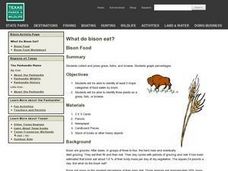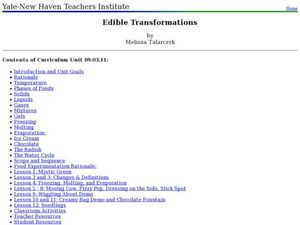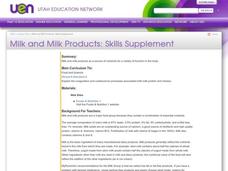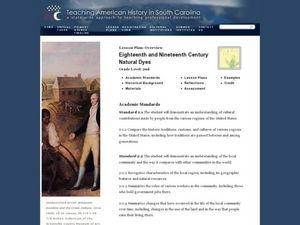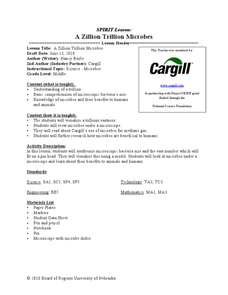Curated OER
COLORS ON THE FARM
Students follow directions regarding what colors farm objects should be
colored. They identify various items pictured on provided worksheet that can be found on a farm or are made from farm animals. Finally, they match each color crayon...
Curated OER
Vocabulary Practice: Fill in the Blanks
In this vocabulary worksheet, students correctly complete sentences, filling in blanks with words from a word pool at the top of the worksheet, 12 sentences total.
Curated OER
Volcanoes of the Deep
Students discuss how organisms relate to one another. They work together to research a specific organism and how it relates to other organisms. They present their findings to the class.
Curated OER
Animal Names
Students match animal pictures with animal words. In this farm animal lesson, students put together the parent and their offspring. Students should have prior knowledge of the basic needs of animals. Students write animal booklets.
Curated OER
Sustainable Livestock
Learners investigate healthy eating habits by researching livestock. In this food sustainability lesson, students research the negative impact factory farming has on our environment due to pollution. Learners define agricultural...
Alabama Learning Exchange
Make a Difference!
We are very dependent upon other life forms around us to survive. Here, scholars explore relationships in the ecosystem with the help of Auntie Litter and the pollution patrol. They imagine a world without grass, making connections to...
Curated OER
Predicate Adjectives
Focus on identifying predicate adjectives in sentences. Use the first sheet to review adjectives and predicate adjectives. Several examples are provided along with brief explanations. Then, move on to the second sheet to put this...
Curated OER
Heart of Darkness: List Group Label Strategy
Heart of Darkness can challenge even the best readers. Here's a pre-reading strategy that will engage class members and provide background and context for Conrad's study of racism, savagery and imperialism. Class members brainstorm,...
Curated OER
Sink or Float?
Have your class explore density and buoyancy using this resource. Learners read the book Who Sank the Boat, and use several items, such as rubber balls, bottle caps, wood, and other household items to conduct an experiment. Using a tub...
Desert Discoveries
What's For Dinner?
Youngsters compare the teeth of plant-eating dinosaurs with those of meat-eating dinosaurs. The concepts of herbivore vs. carnivore are also introduced. There is an excellent worksheet embedded in the plan which shows five skulls of...
Curated OER
What do Bison Eat?
Students identify the three major categories of food eaten by bison. In groups, they collect examples of grass and forbs and press them. They complete a chart of the percentages of each type of food the bison eat in a day. They...
Curated OER
Alphabet Vocabulary
Third graders explore the biodiversity that exist on the prairie. Through reading or listening to books, they keep track of vocabulary words associated with the prairie on an 'Alphabet Poster'.
Curated OER
You Are The Farmer
Students investigate the farming business and occupations in agriculture. Basic multi-step math operations are performed in calculating some of the expenses involved in farming.
Curated OER
Down with Dairy and the Food Pyramid
Students discuss food pyramid, name parts of pyramid, discuss dairy products and how they are beneficial to people, and participate in dairy taste testing.
Curated OER
Sink or Float?
Students will determine whether various objects sink or float in water. They do not need to explain why objects sink or float. They are rather to be encouraged to observe that the same objects will sink or float every time, i.e., that...
Curated OER
Food Chains
Fourth graders study food chains, producers, consumers, and decomposers. They play a food chain game and create food chain mobiles or posters. They take a nature hike around the school and observe various parts of a food chain.
Curated OER
Edible Transformations
Learners differentiate the different phases of matter. In this chemistry lesson, students conduct several hands-on exercises to discover how matter transforms when mixed together. They identify the different stages in the water cycle.
Curated OER
A Meat By Any Other Name. . .
Students, using a New York Times article as a springboard, discuss how food reflects different aspects of a culture and reasons why cultural differences in food are seen as bizarre or, oftentimes, cruel by members of other societies.
Curated OER
Milk and Milk Products: Skills Supplement
Explain the coagulation and coalescence processes associated with milk protein and cheese. List the components of milk and explain how each component is dispersed in the milk. Describe what happens when milk protein is coagulated Discuss...
Curated OER
Soil Soakers
Learners work together to discover the relationship between water holding and drainage characteristics of soils. They record their observations and discuss the results. They examine particle size and pore sizes as well.
Curated OER
Metallic Sounds
Students differentiate between metallic and non-metallic sounds. In this music lesson, students listen to the audio clip of "March" and march in time with the music. Students identify the metallic sounds in the music piece. Students...
Curated OER
Eighteenth and Nineteenth Century Natural Dyes
Second graders explore the work of Americans when it came to coloring materials. For this interdisciplinary lesson, 2nd graders follow the provided steps to make natural goldenrod dye from scratch.
Curated OER
A Zillion Trillion Microbes
Young scholars observe microbes under a microscope. In this biology lesson plan, students describe how Cargill uses them to produce methane. They research the benefits and harmful effects of microbes in society.
Curated OER
The Story of Milk
Students listen while the teacher reads the background information. They discuss the main points of the reading. Students color, cut out pictures, and glue the pictures above appropriate sentences to illustrate the correct sequence in...












